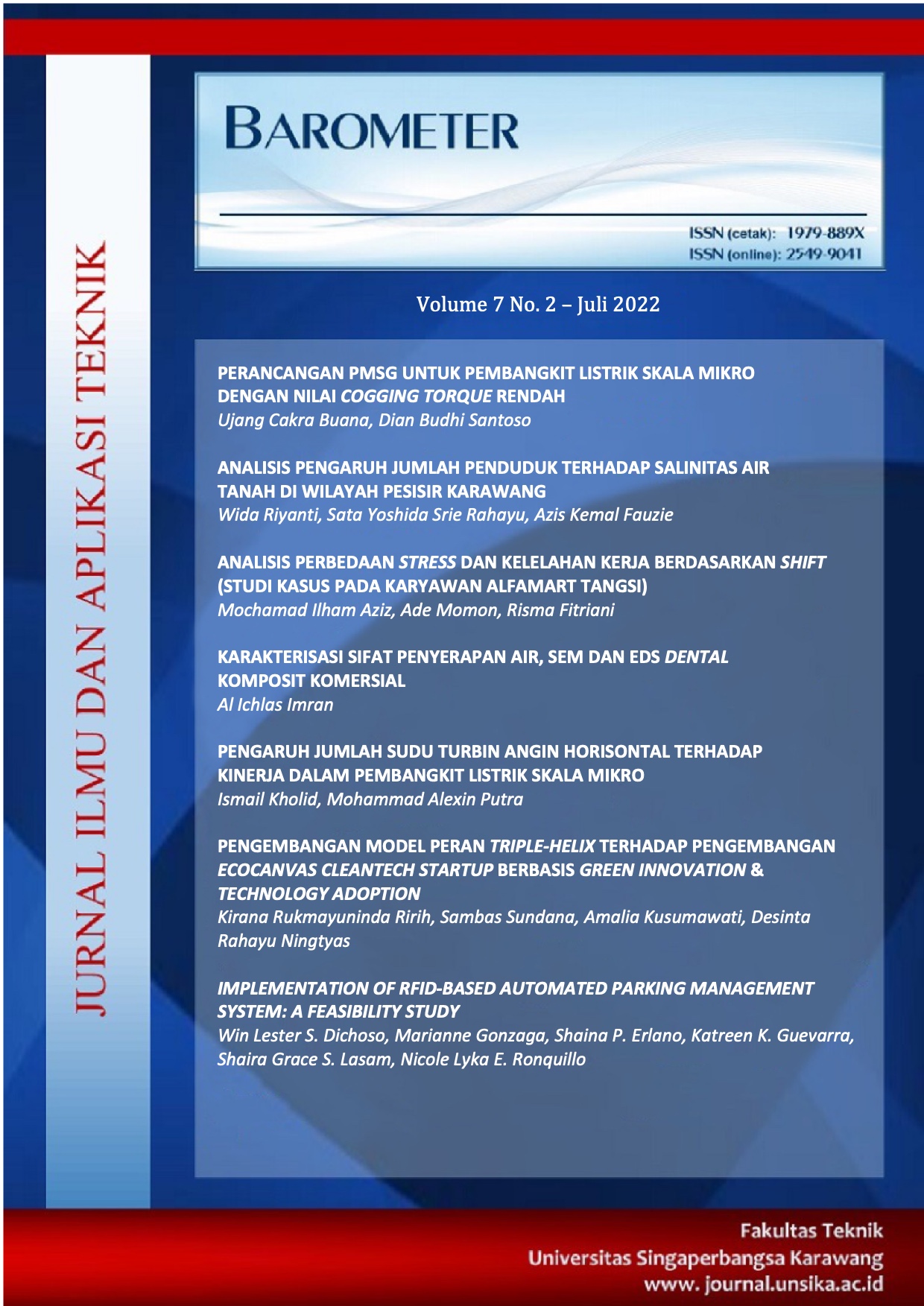ANALYSIS OF THE DIFFERENCES OF WORK STRESS AND FATIGUE BASED ON SHIFT (CASE STUDY ON ALFAMART TANGSI EMPLOYEES)
DOI:
https://doi.org/10.35261/barometer.v7i2.6405Abstract
Work-related activities and exposures make the body susceptible to exhaustion. Fatigue is the body's response to work-related activities and exposures. Psychosocial dangers, essentially job stress with symptoms such as frequent yawning, tiredness, thirst, and difficulties concentrating, are the general response to the high intensity of work. Typically, a job is scheduled in shifts, seasonal employment, weekend work, and overtime, which causes workers to experience exhaustion and a poor quality of life. The purpose of this study was to determine the ratio of work stress and work fatigue using the division of work shifts at Alfamart Tangsi Cikarang. This Alfamart applies 2 work shifts, namely morning and afternoon. This research was conducted by conducting interviews and questionnaires to 4 employees. The work pressure questionnaire uses the OSI-RTM method while the work fatigue uses the 30 Items of Rating Scale. One Way ANOVA was used to test the questionnaire data. The results of the work stress test show a significance level of 0.375 (p>0.05), which means that there is no statistically significant difference in the average work stress between the morning and afternoon shifts. The criterion for the significance of work fatigue is 0.295 (p>0.05), indicating that there is no statistically significant difference in the average level of work fatigue between the morning and afternoon shifts. There is no visible difference in the distribution of shifts at the Tangsi Alfamart location, indicating that the staff does not experience difficulties in dividing the morning and afternoon shifts.
Downloads
References
ILO, Meningkatkan Keselamatan dan Kesehatan Pekerja Muda. 2018.
Kementrian Ketenagakerjaan, “Data Kecelakaan dan Penyakit Akibat Kerja_1603167624.” 2020, [Online]. Available: https://satudata.kemnaker.go.id/details/data/Kasus kecelakaan kerja yang terjadi pada triwulan II tahun 2020 tercatat sekitar 3.174 kasus.
F. Ilham, Yuniar, and L. Irianti, “Strategi Minimasi Stres Kerja Operator Berdasarkan Faktor Pemicu Stres Kerja Pada PT Agronesia Inkaba,” J. Online Inst. Teknol. Bandung, vol. 03, no. 01, p. 143, 2015.
L. Kusumawardani, “Pengaruh Shift Kerja Terhadap Kelelahan Kerja Perawat Wanita Bagian Rawat Inap,” 2012.
V. Marchella, “Stres Kerja Ditinjau Dari Shift Kerja Pada Karyawan,” JIPT ISSN 2301-8267, vol. 02, no. 1, 2014.
I. Sumarto, P. Asfian, and S. Munandar, “Perbedaan Stress Kerja Di Tinjau Dari Shift Kerja Pagi Siang Dan Malam Pada Perawat Di Rumah Sakit Umum Daerah Kota Kendari Tahun 2016,” J. Ilm. Mhs. Kesehat. Masy. Unsyiah, vol. 1, no. 3, p. 183168, 2016, doi: 10.37887/jimkesmas.
Destiani Asmar Mohast, “STRATEGI SISTEM REKRUTMEN DAN SELEKSI KARYAWAN PADA PT . SUMBER ALFARIA Oleh DESTIANI ASMAR MOHAST,” 2019.
K. Konoralma, L. Moningka, and S. Palamani, “Hubungan Shift Kerja Perawat Dengan Stres Kerja Di Ruang Irdm Blu Rsup Prof Dr. R. D. Kandou Manado,” J. Ilm. Perawat Manad., vol. 2, no. 1, p. 92499, 2013.
N. Anastasia, P. A. T. Kawatu, A. A. Rumayar, F. Kesehatan, M. Universitas, and S. Ratulangi, “PERBEDAAN TINGKAT KELELAHAN KERJA BERDASARKAN SHIFT KERJA DI MINIMARKET 24 JAM KOTA TOMOHON PENDAHULUAN Kelelahan kerja Umiyati ( 2009 ) kelelahan kerja adalah merupakan suatu keadaan yang disertai penurunan efisiensi dan ketahanan dalam bekerja . Berdasa,” vol. 10, no. 2, pp. 147–151, 2021.
S. H. Osipow, “Occupational Stress Inventory - Revised EditionTM (OSI-RTM),” Psychological Assessment Resources. 1998.
S. Sample, O. Role, and Q. Orq, “Occupational Stress Inventory - Revised Edition TM ( OSI-R TM ) Report for : OSI-R TM Profile for Sam Sample,” 2019.
N. N. N. Sulistyawati, S. Purnawati, and I. M. Muliarta, “Gambaran Tingkat Stres Kerja Perawat Dengan Kerja Shift Di Instalasi Gawat Darurat Rsud Karangasem,” E-Jurnal Med. Udayana, vol. 8, no. 1, p. 1, 2019, doi: 10.24922/eum.v8i1.45222.
H. H. Janiar and R. D. Astuti, “Analisis Sistem Kerja Shift Terhadap Tingkat Kelelahan Perawat di Bangsal Bedah RSUD Karanganyar Menggunakan Subjective Self Rating Test,” Pros. Semin. Nas. Tek. Ind. Univ. Gadjah Mada, pp. 18–24, 2016.
I. Rhamdani and M. Wartono, “Hubungan antara shift kerja, kelelahan kerja dengan stres kerja pada perawat,” J. Biomedika dan Kesehat., vol. 2, no. 3, pp. 104–110, 2019, doi: 10.18051/jbiomedkes.2019.v2.104-110.
M. Abdurrahman and M. Sulaksmono, “Hubungan Karakteristik Individu dan Shift Kerja Dengan Stress Kerja ( Studi Pada Agent Contact Center PLN 123 PT. PLN ( Persero ) Distribusi Jawa Timur Site Surabaya Tahun 2013 ),” Indones. J. Occup. Saf. Heal., vol. 2, no. 2, pp. 137–144, 2013.
R. A. Simanjuntak and A. D. Situmorang, “Analsis Pengaruh Shift Kerja Terhadap Beban Kerja Mental,” J. Teknol., vol. 3, pp. 53–60, 2010



